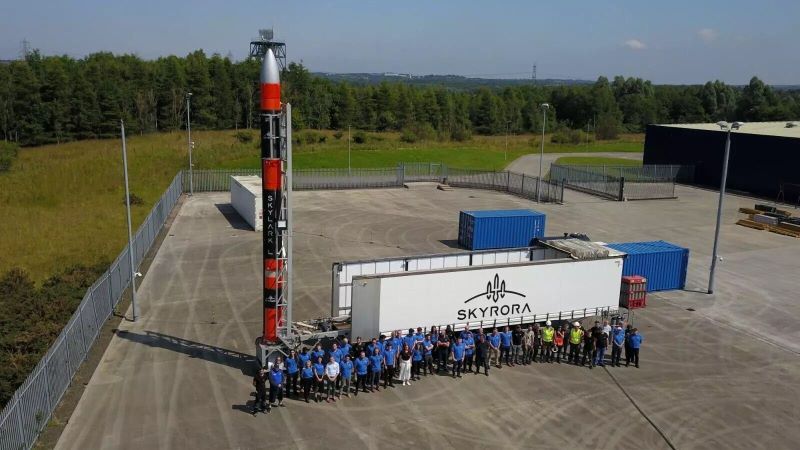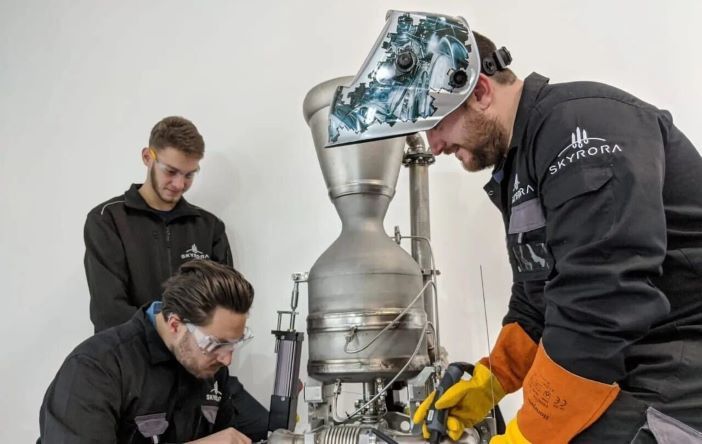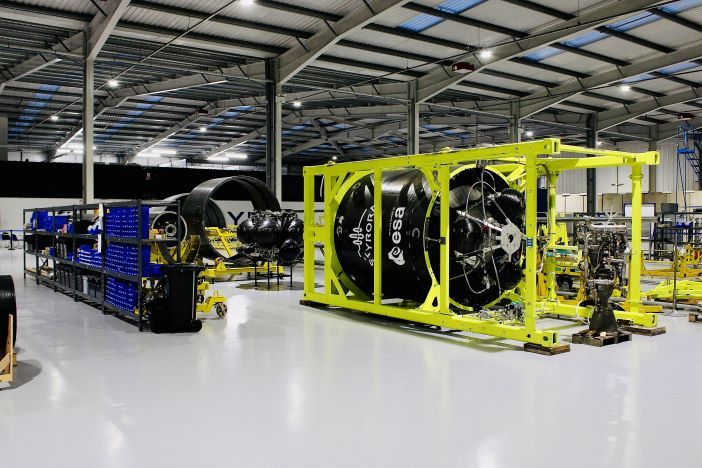It is summer 2022 and television cameras, journalists, politicians and VIPs have gathered at a remote corner of the UK on the western coast of Scotland to watch a 20 second test firing of a rocket engine.
The static firing of the second stage of Skyrora’s XL orbital rocket went without a hitch, much to the relief of Dr Jack James Marlow, head of engineering for Skyrora. He cites the test as one of the most significant milestones for the five year old new space company.
“It was the first time we had tested our integrated second stage with the 70kN engine. It was a big day for the staff and there were a lot of visitors,” he says. “The site was a decommissioned air base, RAF Machrihanish and with the media present it felt like a launch.
“We pushed the button and it all worked great. But more than that, the test was on a scale we had not done before. It let people visualize the rocket and how all the components will come together for the first flight. We packed it away and were gone in five days.”
The static test of Skyrora XL’s second stage attracted media attention because the XL is the largest, most powerful rocket to be made in the UK for almost 50 years. UK engineers have to go back in time to Cold War-era programs such as Blue Streak and Black Arrow for equivalent-sized domestic efforts at rocketry.
Skyrora is changing that with its XL launcher, which it plans to operate from Saxavord Spaceport in the Shetland Isles to give the UK a domestic orbital launch capability for the first time. XL is a three stage, light class launcher intended to place small satellites of up to 315kg (695 lbs) into sun synchronous and polar orbits of between 500 and 1,000km (310 and 620 miles).

The first and second stages of XL will use Skyrora’s 70kN in-house developed Skyforce engine. The first stage will use nine engines and the second just one. Once at the required altitude, another in-house built engine will be used for the third stage. The 3.5kN Low Earth Orbit (LEO) engine can restart in orbit and has already been through a round of ground testing, including in vacuum chambers.
To fuel the engines Skyrora plans to use its sustainable propellant called Ecosene, which is derived from plastic waste. It is developing and testing Ecosene and the production facilities for the fuel in parallel to XL.
XL’s first test flight is planned for 2024 and the first commercial flight from Saxavord should happen at the end of 2024 or during 2025. There is a lot of testing to perform before then, but Marlow is focused on the goal of achieving reliable and repeatable orbital launches with XL. He understands the scale of the challenge and the significance to the UK of developing the launch platform.
Marlow’s understanding is enabled by his background in propulsion systems testing. Before joining Skyrora in 2018 as its sixth employee he was a postdoctoral researcher and lecturer in space engineering. He is also a fellow of the Royal Aeronautical Society. “I must have managed 250 hot fire tests during that time,” he says. “With Skyrora that number has maybe quadrupled.
“I’m now more involved in engineering management. For example, managing timelines for qualifying the engines, deciding when we bring in quality management systems for the first launch and working with our regulator, the CAA to get our launch license.”
Test site
After the testing at RAF Machrihanish the team returned to Skyrora’s permanent testing site, which was commissioned earlier in May 2022. The £3 million (US$3.7 mllion) test facility took two years to design, build and commission and was a challenging project.
With no sites suitable to support the scale of Skyrora’s ambitious test program in the UK, the company had to build the country’s largest and most advanced rocket testing site itself. The team identified four potential sites in Scotland. This was quickly whittled down to a single location – a disused quarry 17 miles (27km) south of Edinburgh.
Surprisingly the biggest risk to the company at this stage became a newt. “We had invested in our test sites and planned everything. Then one day someone found a newt. We had to call the planners and someone came and took it away,” says Marlow.
If the amphibian was a Great Crested Newt it was a protected species. The project would have to be stopped and another site selected. A common newt would mean the company could just pay for it to be relocated. “The newt had to go away for NDT testing. One day, we sat around the phone waiting nervously to find out the results. Luckily for us it was a common newt,” Marlow says.
“These are the kind of risks you have to deal with. We are pushing at a new frontier in the UK and this type of launch has never been done here before. No matter how many courses you do, you can never prepare for everything, there will always be unknowns.”
Other natural features at the site are beneficial. All of the structures, including the tripod test stand, sit 10m (32ft) below the lip of the quarry. Water from a stream is used for the cooling the deluge systems. Skyrora’s engine emissions also produce 45% less CO emissions than normal liquid oxygen and kerosene engines.
Knowledge also became an issue during development. The last rocket testing site of the size Skyrora required was built more than half a century ago in the UK and has long since been mothballed. The team was starting from scratch with many technical aspects of the site and resorted to scouring archives at Rolls Royce.
“In the end, and this is one of key differentiators from other sites, we opted to build everything with containers,” says Marlow. “The modular approach allowed us to quickly swap things around and iterate for the correct final design.”

Qualification to acceptance
Skyrora employs around 50 engineers. Although the company offers a range of sounding and suborbital rockets, their primary focus is XL development. The 70kN engine qualification test program is ongoing and engineers are progressing steadily with R&D of the third stage vehicle, which is contained in the nose cone of the rocket and places payloads into orbit.
The third and second stages have been through static fire testing campaigns. The team is finalizing the first stage design, has started manufacturing the prototype and plans to start assembly soon.
The 70kN engine test qualification campaign is being done to meet ECSS (European Cooperation for Space Standardization) requirements. It is running around 35 to 50 tests and involves five engines. Skyrora was halfway through the program in July 2023. Developmental testing ended in March 2023 and used two prototype engines to demonstrate the design can operate, startup and shutdown at nominal levels.
After successful system reviews the next three engines were built. These qualification models are the same mass as the final launch models and use the same components. The correct performance has to be obtained with these models. Testing of these engines includes live simulations that last up to 250 seconds each firing, twice the time that will be needed for an XL launch. “We are really pushing the operating envelope during testing,” says Marlow.
“For example, we increase the chamber pressure and the oxidized fuel ratio.”
70kN is a massive step up in terms of the size of the explosive potential and means that the tests need a safety radius of 150m (500ft), hence the large size of the facility.
Once qualification testing is completed, and manufacturing of the 70kN engine is established, the facility will fulfil its longer term purpose and test every engine produced by Skyrora. Several operational aspects of the facility will change for acceptance testing, which compared to the qualification tests, are shorter in duration and do not need to increase pressures and flow rates to levels that will stress test the 70kN engine design. Acceptance testing for each engine will require a nominal 20 second hot fire test, for example.
Meanwhile, ground static testing of the first stage, with its cluster of nine engines is the next major project milestone. The stand is configured to accommodate vertical firings for the first stage. During these tests the rocket is fully integrated with avionics and runs with its mission computer to simulate full flight. Engineers will aim to balance the engines with the flow rates of fuel from the tanks and rehearse the operational aspects of launch – filling and defueling for example.
“The vertical format means we are testing the engine in it’s correct configuration, in a similar way to its operational environment. Vertical is also safer. A risk when testing a large engine horizontally is pooling. An incorrect start up/shut down can result in propellent pooling in the chamber and cause detonation events” says Marlow.
Manufacturing
In parallel to the ground testing, Skyrora will continue to refine its manufacturing processes. The 70kN engine will be made at the company’s facility at Cumbernauld, Scotland which is already operational. Marlow says, “We are already working out floor plans, throughputs and cycle times for engine manufacturing. We’re bringing in AS9100 quality standards and working hard so we can scale up quickly.
“At the moment an engine takes us around two months to fully manufacture and test. We have got to get that down to a week for initial commercial operations.”
Production of the 70kN engine uses another in-house innovation, an additive manufacturing machine that prints in Inconel 718 and uses a Direct Energy Deposition (DED) process. DED brings powder through into a nozzle, where it hits a laser which melts it while it drops into place. DED has the advantage of being as fast as laser sintering.
“We developed our machine simply because there was no machine big enough at the time for the scale of our engine as an all in one. We didn’t want to change our design to sacrifice what we wanted to achieve in terms of lean operations and throughput,” says Marlow.

Skyprint makes the engines in a single operation within a print area of 1m x 1m x 2m to minimize the amount of welds and joins. It can also machine at the same time as printing, enabling more complex designs. Vitally, hollow parts of the engine can be produced in a single take with the technology.
“As an example, our engines have a cooling jacket, so Skyprint lays the metal and the hollow chamber. Using DED and machining we print, cut, then reprint to get the complex geometries we want quickly,” says Marlow.
AM is suitable for rocket engine applications because unlike aircraft engines and structures, which have to endure cyclic loading and constant stresses, rocket engines only operate for a short time and are then disposed of. Marlow estimates the use of AM enables production time savings of around 60% and cost savings of around 20% per engine.

Regulatory issues
As well as ecological considerations, there are several other non-technical aspects to manage when developing and operating a commercial space launch capability. Marlow says, “When we first started there was a lot of unknown unknowns. Now there are known unknowns and we are still working through them.
“A major one is the regulatory process. When we started out the Space Act hadn’t even been passed in the UK. The lower-level regulations weren’t published until 2021. We had to base our work off the USA’s FAA standards.
“Today, as well as the regulators, we are working with politicians and many different stakeholders, the needs of whom all have to be balanced while we keep the engineering on track. And then there are the business considerations – assessing how the space launch market is developing. There are a lot of different facets to balance other than just the engineering
and technology.”
With interest in the project high, all eyes will return to Scotland when XL’s first flight is made. All the risks that can be considered will be by Marlow, newts and all, but
there will always be unknowns.





